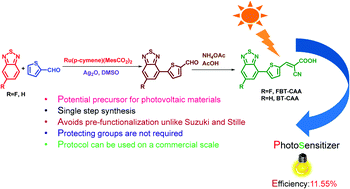Access to small molecule semiconductors via C–H activation for photovoltaic applications†
Abstract
The first methodology of ruthenium carboxylate-catalysed single step oxidative cross coupling that challenges the conventional Stille and Suzuki coupling reactions, affording BT and MFBT derivatives in the absence of protecting groups, was developed. Both mono and bi-arylated derivatives are formed in moderate to high yields (30–75%). Innately high selectivity, low catalyst loading and lack of formation of regio-isomers ensure the large-scale synthesis of various photonic and electronic materials employing this method.



 Please wait while we load your content...
Please wait while we load your content...